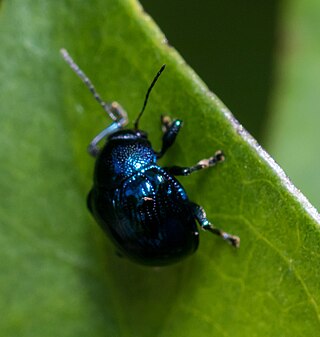
Colasposoma is a genus of leaf beetles in the subfamily Eumolpinae. It is known from Africa, Asia and Australia.

Platycorynus is a genus of leaf beetles in the subfamily Eumolpinae. Species of the genus are found in Africa and Asia.
Ennodius murrayi is a species of leaf beetle of Guinea, Ivory Coast, Nigeria, Cameroon, Equatorial Guinea, the Republic of the Congo and the Democratic Republic of the Congo, described by Félicien Chapuis in 1874.

Rhembastus is a genus of leaf beetles in the subfamily Eumolpinae, native to Africa. Whilst the taxonomy of the genus is disputed, the genus has been suggested as a biological control agent for Bryophyllum delagoense in Australia.

Macrocoma is a genus of leaf beetles in the subfamily Eumolpinae. It contains about 100 species, which are found in tropical Africa, around the Mediterranean, on the Canary Islands, in western and central Asia, and in India.

Afroeurydemus is a genus of leaf beetles in the subfamily Eumolpinae, found in Africa. The genus was separated from Eurydemus in 1965 by Brian J. Selman, who moved all African species of Eurydemus he had seen to this genus or related African genera and considered it likely that Eurydemus was restricted to Fiji. Many species were also originally placed in Syagrus.

Paraivongius is a genus of leaf beetles in the subfamily Eumolpinae. It is distributed in Africa.

Pseudocolaspis is a genus of leaf beetles in the subfamily Eumolpinae. It contains about 80 species, which are found in tropical Africa.

Typophorini is a tribe of leaf beetles in the subfamily Eumolpinae. The tribe contains approximately 100 genera, which are found worldwide. Members of the tribe are mainly characterized by notches on the tibiae of the middle and hind legs, which are sometimes referred to as antenna cleaners. They also generally have a subglabrous body, as well as bifid pretarsal claws.

Eurydemus is a genus of leaf beetles in the subfamily Eumolpinae. It is known from Africa and Fiji.
Eryxia is a genus of leaf beetles in the subfamily Eumolpinae. It is distributed in Africa and Western Asia.
Pagria is a genus of leaf beetles in the subfamily Eumolpinae. It is known from Africa, Asia and Australia.
Obelistes is a genus of leaf beetles in the subfamily Eumolpinae. It is known from Africa.
Basilepta is a genus of leaf beetles in the subfamily Eumolpinae. It is generally distributed in Asia. A single species is also known from central Africa.

Cleorina is a genus of leaf beetles in the subfamily Eumolpinae. It is known from Australia and Asia.
Pathius is a genus of leaf beetles in the subfamily Eumolpinae. It is known from Africa and the Arabian Peninsula.

Trichochrysea is a genus of leaf beetles in the subfamily Eumolpinae. It is distributed in Asia.
Allocolaspis is a genus of leaf beetles in the subfamily Eumolpinae.

Bromiini is a tribe of leaf beetles in the subfamily Eumolpinae. The tribe contains approximately 120 genera, which are found worldwide. They are generally thought to be an artificial group, often with a subcylindrical prothorax without lateral ridges and covered with setae or scales.











